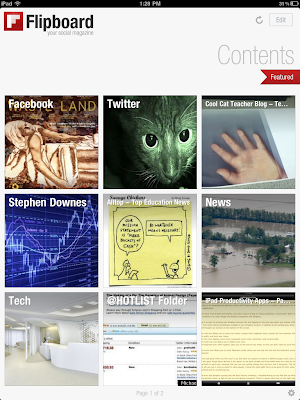 |
| Home Screen of my Flipboard |
Flipboard is a phenomenal reading app for the ipad and was
the big reason I begged my family to give me one for my birthday.
However, because so little content is really produced FOR the flipboard, you have to know how to add it. You only get two screens of content (for now) so use it well.
To get Started...
To follow these instructions, you'll need to download
Flipboard onto your
iPad.
A look at what is on my flipboard....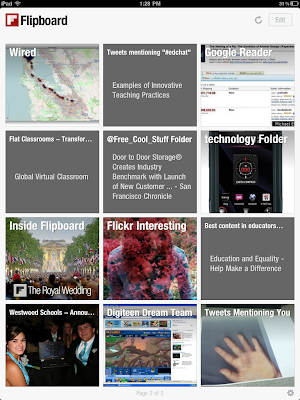
Before we begin, let's take a look at screenshots of my two Flipboard screens. The sources of information are printed in the top left corner of each board.
Sharing from FlipboardBefore we get to the reading part, you can share content within Flipboard. What you can do depends upon the content source. If you're reading from Facebook, your like and comment buttons show. If you're reading from Twitter, you have retweet, retweet with comment and favorite. Google reader gives the sharing features available in reader.But, Flipboard's "Button of power" is always in the top right hand corner of any screen. This "share" button lets you send the link to any of the social media sites you have set up. (For me, it is Twitter, Blogger, and Google Reader.)Adding Content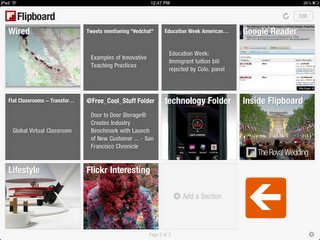 |
| The Add a section button is shown beside the arrow. |
To add content, you just click on the blank gray square on your starting screen that says Add content. Admittedly, I've deleted over half of what I've added as I've played with Flipboard. If the content isn't updated or not quite right, it isn't usable.
For educators, I'll recommend the educator link or item. For non-educators, I'll give pointers on how you can find something similar in your professional arena.
15 Fantastic Use of Flipboard.1 - FeedSubscribe to your own twitter timeline. Flipboard will make the tweets and turn it into a lovely magazine. It is interesting to see the different nature of your twitterstream depending on the time of day. I find more teachers tweet after school hours (understandably so) and admins seem to tweet DURING school hours.
(Interesting study waiting to happen on that one.) 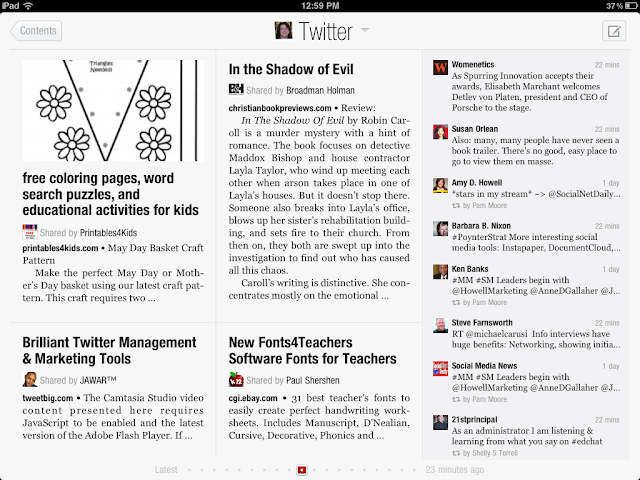 |
| Flipboard from @coolcatteacher Twitter stream (what those I have friended are writing.) |
There are many now who are unfollowing on Twitter en masse as they try to improve their "
Klout" score, however, I want to follow just about anyone in education and especially teachers. There is a certain random beauty that emerges from this and I "drill down" to my friends by using lists. It is all about why you Twitter but Flipboard makes it easy to read whatever your motivations or reasons.
How to add: Click Add and add an account and set up your Twitter Account.
2 - Twitter ListsSo, if you follow a LOT of people, you can also slice this down to a smaller group by making a twitter list. You'll have to publish it and then subscribe. If it is public, you'll need to know the name of the list but if it is private you can make a list of your closest friends and follow that way.
This is also a great way for those who hate twitter and will not use it to harness the power by finding a list of people from a credible source to follow. (I kind of like
chalkstars.)
How to add: Search for the name of the twitter list (it must be public) and then scroll down to the "Twitter Lists" section if it is for someone else. Otherwise, after you've added Twitter, just click on Add Section and click Twitter and then you can add your own lists.
3- Twitter Hashtag - #edchatMy favorite Twitter based flipboard magazine for educators is from #edchat. Just type #edchat in the search and scroll down to follow the hashtag. If you are in another field, you should look at the common hashtags in your field. When you attend conferences, you may want to have a temporary Flipboard "magazine" for that hashtag. (like #iste11).
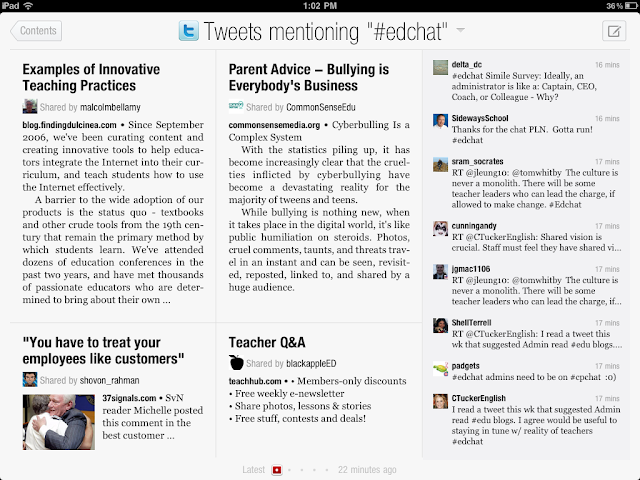 |
| #edchat hashtag on Twitter is one of the best feeds to compile on Flipboard. |
How to add: Type #edchat
(or any other hashtag) Scroll down to the
Twitter Search Section and subscribe to "tweets mentioning #edchat"
4 - Other Twitter FeaturesYou can follow tweets mentioning you, saved searches, your lists, lists you follow, lists following you, people you follow, and people following you! So many things. My advice is to be strategic. Your Flipboard should meet a need and should evolve.
How to add: After you've added Twitter, click on Twitter after you add a section and then select what you'd like to add.
5 - Google ReaderSubscribing to all of your google reader will bring everything mixed together. It makes for interesting reading and customized magazine of sorts.
How to Add: Click Add Section and then add the network and subscribe to it.
6 - Google Reader FolderI have a folder called @hotlist that includes the blogs I want to make sure that I read almost every day. This is on my flipboard. I also follow a folder labeled @freecoolstuff that includes some that scrape information about free things for educators and my classroom.
How to add: Click Add section and then click Google Reader
(if you added it for #4 above) and then click
Subscriptions. You can then pick a folder in your google reader. If you don't have a folder, you'll need to go to
http://reader.google.com on your web browser and set them up.
7 - Public NingsI subscribe to the Flat Classrooms ning to pull out current content. I'm still working on this as I'm not sure how the RSS is coming out of the
Ning - sometimes it has older things.
How to add: Click
Add Section and then type in the URL - this one is
http://flatclassrooms.ning.com - Again, I'm working on this one. You could also use the specific RSS feed for what you want to follow on that topic.
8 - My own BlogI am learning about how things deploy into Flipboard, so I follow my own blog. If you blog, you follow yours.
How to Add: The fastest way to add this is to type the url in flipboard. Mine is
http://coolcatteacher.blogspot.com
9 - Any school or classroom blog that is published publicly.I subscribe to my school's blog at
http://westwoodschools.blogspot.com to follow the content and to show parents how it is done. I plan to write a blog post to show them how as it is so easy to read school news that way. I also have
http://digiteendreamteam.blogspot.com a blog run by some of my ninth graders.
This is a great tip for administrators who are nervous about their students producing public content as it is easy to read and respond.
How to Add: Type the URL in flipboard and subscribe.
10 - Best of a Diigo GroupThe
educators group on Diigo is one of my favorite go-to places for information.
(See instructions for how to join properly or you will be delayed in the approval process. spammers beware.)How to Add: To subscribe, I typed in educators and diigo and then it found the diigo group. The group must be public.
11- Education AllTopThe
alltop education resource is one of the best. Founded by
Guy Kawasaki, if you are in education, this is a must add to your flipboard. There are alltops in many subjects - go to
www.alltop.com. Great flipboard content.
How to Add: Type education alltop and find it or
http://education.alltop.com 12 - Resource Sharing Blogs (OL Daily)Frequently updated resource sharing blogs make excellent flipboards.
Stephen Downes is in this category for me. I want to read pretty much everything he links to because it is a wide variety and "he can't be bought." I typically don't subscribe to advertising-type blogs in this category because I've found it gets cluttery.
How to Add: Type in the URL or search for the person's name.
13- Your Facebook News FeedAdd Facebook and Follow everything that comes through your network.
How to Add: Add a network and then subscribe.
14 Photos that Tag YouYou can subscribe to all photos on Facebook that tag you in them.
(Honestly, if you had the userid and password for a person you could subscribe to the photos they are tagged in - like your younger children. You'd just have to promise not to comment. ;-))How to Add: Add a network and then click Facebook and choose "Photos of You"
15 - Other Important Things in Facebook (Groups, Your Wall, Friend Lists, Pages, Friends, News Feed Links, News Feed Photos)
You can drill down facebook in many ways. This is great for school who want to have a Facebook page but need to keep an "eye" on things.
How to Add: Click Facebook and drill through the menus. There is more there than can be added to a flipboard.
Let it Flow and EvolveYou are a human being bounded by finite time and attention spans. You are not infinite so you must focus your energy in ways that pay powerful dividends.
If a Flipboard isn't useful, delete it. It is better to have 3 useful boards than 2 screens of things that distract you.
Delete What Doesn't WorkFor that matter, if you hate Flipboard, delete it. Any device no matter how useful can be a productivity killer if it becomes the master and not the servant.
This is your life. It is your job to have the self discipline to focus your time and energy on what is important to you.
This is Your Life!When I turned 42 this past Monday, I was running on the track and saw the sprinkler system come on the football practice field. Instead of staying on the track, every time I came close to the sprinkler - I ran through it. It felt great! As I listened to my ipod I heard the words:
"It's my life. Now or never. I ain't gonna live forever. I just gotta live while I'm alive."
Life is changing rapidly as we replace desktops with tablet and mobile devices faster than most can comprehend.
Look for the tools and things that add to your life. If it doesn't add to it, delete it. This is your life! I think Flipboard adds to mine! Enjoy!

































